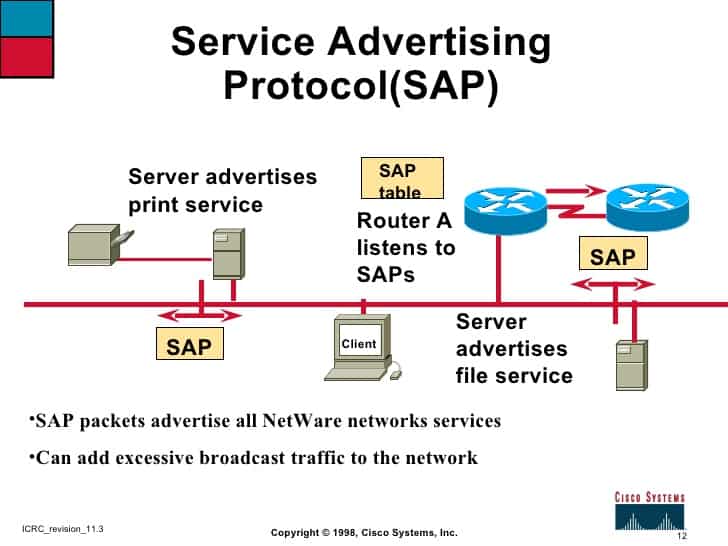Definition of Service Advertising Protocol (SAP) in the Network Encyclopedia.
What is the Service Advertising Protocol?
Service Advertising Protocol, also known as SAP, is a Novell NetWare protocol that is used with Internetwork Packet Exchange (IPX) to enable file and print servers to advertise their availability to clients on a network.

Service Advertising Protocol (SAP) periodically advertises the address of the server and the types of services it can provide to clients. It sends its advertisements by making frequent broadcasts to all machines on the local network. Routers generally forward the advertisements so that network services can be made available to machines throughout an IPX internetwork.
SAP Broadcasts
The use of SAP broadcasts on IPX internetworks creates effective limits on the size of a usable IPX internetwork. However, you can configure routers to reduce unnecessary SAP traffic by
- Filtering unnecessary SAP broadcasts using access lists on routers
- Using Cisco Systems IPX routers that allow SAP broadcasts to contain update information only, instead of the entire SAP table, and to forward SAP updates only when a change to the SAP table has occurred
SAP Service Types
| Value | Meaning |
|---|---|
| 0x0001 | User |
| 0x0002 | User group |
| 0x0003 | Print queue |
| 0x0004 | File server |
| 0x0005 | Job server |
| 0x0006 | Gateway |
| 0x0007 | Print server |
| 0x0009 | Archive server |
| 0x000A | Job queue |
| 0x000B | Administrative object |
| 0x0021 | SNA gateway |
| 0x0024 | Remote bridge server |
| 0x0027 | TCP/IP gateway |
| 0x0047 | Advertising print server |
| 0x8000-0x7FFF | Reserved |
| 0xFFFF | Wildcard |
Request for Comments for Service Advertising Protocol
RFC 1582, page 20:
Netware [Novell Incorporated, “IPX Router Specification”, Version 1.10, October 1992.] supports a mechanism that allows servers on an internetwork to advertise their services by name and type using the Service Advertising Protocol (SAP) which runs over the Internetwork Packet Exchange (IPX) protocol using socket number 452h.
SAP operates on similar principals to running RIP. Routers act as SAP agents, collecting service information from different networks and relay it to interested parties.
To support the triggered update mechanism outlined in this proposal the packet format for Netware SAP is modified.
RFC 1582, pages 1 and 2:
Routing information is sent on the WAN when the routing database is modified by new routing information received from another interface. When this happens a (triggered) update is sent to a list of destinations on other WAN interfaces. Because routing protocols are datagram based they are not guaranteed to be received by the peer router on the WAN. An acknowledgement and retransmission mechanism is provided to ensure that routing updates are received.
The WAN circuit manager advises the routing applications on the reachability and non-reachability of destinations on the WAN.
RFC 2091, pages 3 and 4:
Periodic broadcasting by Bellman-Ford (distance vector) algorithm information broadcasting protocols IP RIP, IP RIP V2 or Netware RIP and SAP generally prevents WAN circuits from being closed. Even on fixed point-to-point links the overhead of periodic transmission of RIP – and even more so SAP broadcasts – can seriously interrupt normal data transfer simply through the quantity of information which hits the line every 30 or 60 seconds.
To overcome these limitations, this specification modifies the distance vector protocols so as to send information on the WAN only when there has been an update to the routing database OR a change in the reachability of a next hop router is indicated by the task which manages connections on the WAN.
Because datagrams are not guaranteed to get through on all WAN media, an acknowledgement and retransmission system is required to provide reliability.
The protocols run unmodified on Local Area Networks (LANs) and so interoperate transparently with implementations adhering to the original specifications.
Multiprotocol routers are used on connection oriented Wide Area Networks (WANs), such as X.25 packet switched networks and ISDN networks, to interconnect LANs. By using the multiplexing properties of the underlying WAN technology, several LANs can be interconnected simultaneously through a single physical interface on the router. A circuit manager provides an interface between the connectionless network layers, IP and IPX, and the connection oriented WAN, X.25, ISDN etc.
RFC 2091, page 12:
To support the mechanism outlined in this proposal the packet format for Novell SAP is modified when using Operations Update Request (9), Update Response (10) and Update Acknowledge (11).